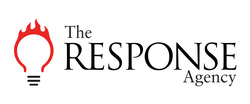A strong logo sets your product or service apart from that of competitors. It’s not hard to pick out TIME or NEWSWEEK on a newsstand. By contrast, there is a magazine whose art directors cannot resist giving it a new masthead each month. More than once, I have failed to recognize it in my mail, mistaken it for an unwanted magalog, and unwittingly chucked it.
A logo says something about you. It can make you look viable, or not. You know: first impressions and all that. For that reason, do not, repeat, DO NOT let an amateur design it, or it will say that you are an amateur. Don’t whip one up yourself, either, and don’t use clip art.
A logo can create content. I’ll use the RESPONSE Agency logo for an example. Branding shops often accuse direct marketers of lacking creativity, so I challenged Britain Morris, our art director at the time, to come up with a logo showing that we indeed are creative. I shall let you judge for yourself how he did. (I told him not to use a light bulb, because it’s a cliché. As you can see, he defied me. I am glad.)
You can have a symbol as part of your logo, but there is no law requiring it. Your name can be a logo, all by itself. Think Google, Xerox, Coke, and Kodak.
If yours is a small company, do not expect your logo to be come widely recognizable. But do expect it to set you apart and make a statement about you.
—Steve Cuno

 RSS Feed
RSS Feed



